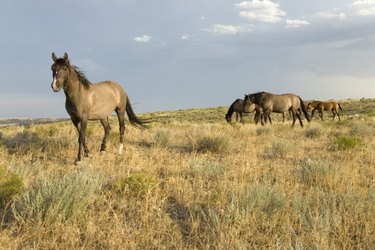
The grassland biome is also called prairies, steppes and plains. It is a flat area that has periods of drought and thin soil so that trees cannot survive. Grassland biomes are found in the middle latitudes and in the interiors of continents. Grass is the predominant plant found in the grassland biome, but other common plants and animals also are found there.
Yellow-eyed Grass (Xyris sp.)
Video of the Day
Yellow-eyed grass is not really a grass. This common grassland plant has showy yellow flowers that are pollinated by insects. Numerous species of yellow-eyed grass populate grasslands in North America.
Video of the Day
Milkweeds (Asclepias sp.)
Milkweeds are important to the grasslands ecosystem. Insects try to feed on the sap from milkweed leaves or stems, but it hardens in the air and damages the insect's mouth. The sap also contains bad-tasting, poisonous chemicals. Only the monarch butterfly, the milkweed bug and red milkweed beetle are able to digest the noxious milkweed chemicals. This makes desirable insects like the monarch butterfly poisonous to predators. Bright colors warn predators of the poison.
Queen Ann's Lace (Daucus carota)
Queen Ann's Lace is a member of the parsnip family and related to the garden carrot. It is not native to North America but is now found in North American grasslands. Queen Ann's Lace produces beautiful lacy flowers with black in the center of the inflorescence.
Bison (Bison bison)
Bison are large herbivores that used to migrate with the seasons more than 100 years ago to feed on the best young grass. The American bison is also called buffalo. There used to be millions of American bison in North American grasslands. Today, migration for them is difficult because of fences and interstates, and the American bison is on the endangered species list.
Pronghorn (Antilocapra Americana)
The pronghorn is an unusual animal. It resembles an antelope and a goat but it is neither. It has a white underbelly and the males have horns that look like antlers. Antlers are usually shed but not horns, yet the pronghorn sheds its horns. The pronghorn can run up to 30 mph.
Feral Horse (Equus sp.)
Wild horses are great grassland animals since they can run, kick, bite and stomp predators. They also live in herds, which gives them additional protection against predators.